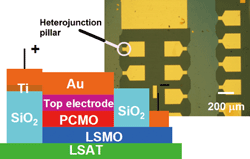Oxide Switch
I. Ohkubo and M. Lippmaa
Various oxide thin film-based switching devices have been proposed. Non-volatile switching between conducting and non-conducting states can occur under the influence of electric field, as in resistive switching, or by some other form of external excitation, such as light illumination or exposure to a magnetic field. In the present work, the purpose is to fabricate a trilayer oxide thin film device structure that can be used to measure transport in the perpendicular direction across a heterointerface as opposed to the more common planar geometry, in which transport is measured parallel to an active interface, e.g. in a field-effect transistor.

Fig.1. The switching devices are grown on (LaAlO3)0.3-(Sr2AlTaO6)0.7 (LSAT) substrate. The bottom electrode is a metallic (La,Sr)MnO3 layer. Switching occurs either in the Pr1-xCaxMnO3 (PCMO) layer or at the top electrode interface. Vertical transport through the heterostructure occurs in micron-scale pillars that are etched into the thin film multilayer, shown in the inset photo.
A cross-sectional schematic diagram and a plan-view photo of a lithographically patterned device are shown in Figure 1. The thin film multilayer consisting of (La,Sr)MnO3 and Pr1-xCaxMnO3 is fabricated first by pulsed laser deposition, followed by a lithography step and ion milling that exposes and forms the shape of the LSMO bottom electrode. In the second step, the PCMO pillar structure is surrounded by a SiO2 isolation layer and the device is finished by fabricating top metal electrodes by a lithographic lift-off process. Each sample contains several tens of pillar structures with diameters ranging from 5 to 50 μm.
Work is proceeding on characterizing the switching properties of these pillar samples. In case the top electrode is Aluminum, resistive switching occurs at the electrode / PCMO interface, driven by a field-induced formation of aluminum oxide at the top interface of the PCMO film.
Since the LSMO electrode and PCMO switching layers are both ferromagnetic oxides, it is also possible to study the magnetic properties of confined oxide microstructures and follow the transport properties of the magnetic heterostructures under external magnetic fields.
References
- T. Harada et al., Appl. Phys. Lett. 92, 222113 (2008).
- K. Tsubouchi et al., Appl. Phys. Lett. 92, 262109 (2008).
- I. Ohkubo et al., Mat. Sci. Eng. B 148, 13 (2008) .
